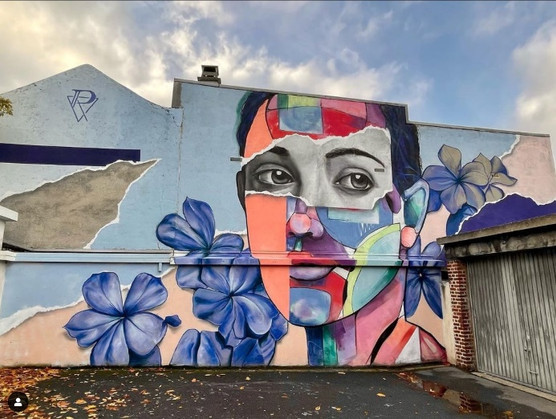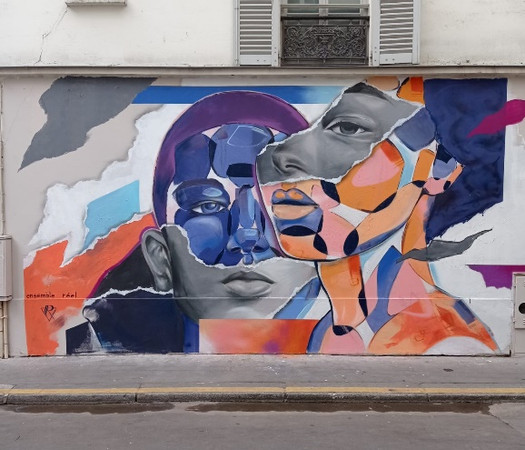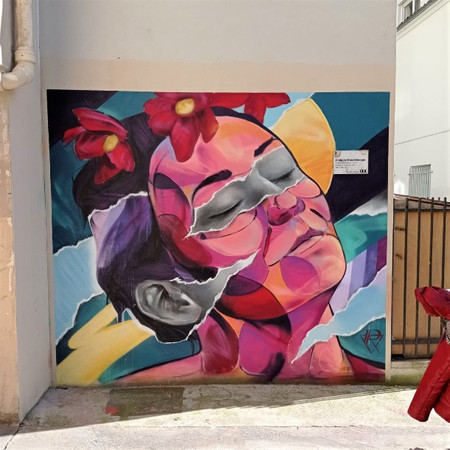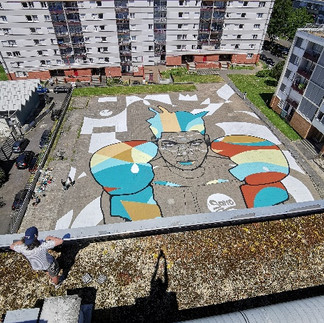NO ONE CAN LIVE ALONE
- Riccardo Aimerito
- Apr 13, 2023
- 4 min read
"STREET ARTISTS ENSEMBLE REEL: TWO BROTHERS, ONE LEFT HAND,
ONE RIGHT HAND"
HOW DID YOU APPROACH STREET ART AND GRAFFITI?
We have been drawing since we were little, it has always been part of our lives. But drawing remains an individual activity, we are alone in front of our paper. During our teenage years, graffiti was for us the opportunity to share the same passion with friends, to challenge each other, to make progress. I would say that at that time the group was more important than the desire to do something illegal.
WHAT IS YOUR DEFINITION OF STREET ART?
Nowadays the word "street art" is used everywhere, it has become popular and often misused.
For us, street art is not a graphic style. It is an approach. To offer artistic forms in the street to anyone who wants them, whether it is plastic or living (dance, music, theatre, painting). This is the only place where art is imposed on people.
STREET ARTISTS – IN PARTICULAR GRAFFITI - ARE SOMETIMES STILL CONSIDERED TO HAVE A SORT OF ANARCHICAL MATRIX, WHEREAS YOU TALK ABOUT FUNCTION IN THIS SOCIETY, SO SOCIETY IS IMPORTANT FOR YOU? HOW AND WHY?
Since you illegally paint in the street, there is necessarily a committed approach, without being militant. It is illegal from the beginning and paint without asking permission carries certain risks. But we are ready to take them to convey our poetry. Many people do not appreciate the simple fact of illegally painting works on the street, regardless of the message behind them. They see it as an act of degradation. For us, moving someone when he/she comes across one of our urban works takes priority over everything else.
Some people see it as a form of anarchy, where you have your own rules and want to impose them… That may be true and is not a problem for us. However, the first desire is not to cause damage, but to convey a poetic and benevolent idea in this society, which is certainly important, because no one can live alone, but it is too focused on individuality and our artwork is focused on empathy.
Doing things illegally may be an anarchic vision, but it is still a social action.
AUTONOMY AND FREEDOM, WHAT DO THEY MEAN TO YOU? WHAT SHOULD AN ARTIST DARE TO DARE?
Individually, freedom is not measurable, because every action depends only on oneself. We are free in front of our blank canvas in the studio, but this freedom cannot be compared to that in the face of danger.
We are free from everything only in front of a wall because we take the right to be. It is a selfish freedom because it potentially disturbs someone else's freedom. That is why we have no problem with the ephemeral aspect of things.
Regarding autonomy...being a couple, it would be a lie to say that each of us is 100% independent. Although we constantly share ideas, the result of an artwork inevitably depends on the other.
An artist must dare to free himself from the codes imposed on him to be as sincere as possible, to dare to do things without being afraid of how his work will be seen.
Failure is part of the learning process.
YOUR SLOGAN IS: "TWO BROTHERS, ONE LEFT HAND, ONE RIGHT HAND, JUST ONE ARTIST WITH TWO HANDS?” HOW DO YOU PROCEED TO MAKE THE DIFFERENT WORKS?
Each of them has a particular style: one will work first with roundness and colour, while the other is more inclined to a black-and-white image close to reality. It is important for us to deal with these two distinct identities and find a complementarity without merging them. While the graphic styles are different and specific to each one, all the considerations about the tears regarding the arrangement of the various pieces are done together.


IN YOUR WORKS, YOU MIX REALITY WITH COLOUR AND GEOMETRIC ELEMENTS, COULD WE SAY THAT THESE ARE YOUR TWO PERSONALITIES?
Nobody has ever asked us this question, and there is probably some truth in this analysis.
Even before we started painting together, we had already noticed a difference in our individual paintings: one was abandoning brushstrokes, while the other was aiming for more precision.
Regarding the colour and black and white, this is instead a common artistic choice. The idea of the contrast between colour and black and white highlights a complexity present in each of us and gives a desired visual power.
But overall, we are similar in many ways.
MELANCHOLIC SUBJECTS OR SOMETHING ELSE? AND IN PARTICULAR IMAGINARY FACES OR REAL PEOPLE?
In a few months, we will be presenting a personal exhibition, and for the occasion, we are exploring other worlds besides portraits.
But it is true that we have specialised in portraits of strangers until now. We use real photos as our starting point and then leave ourselves the right to modify certain facial features. The idea is not to recognise the person represented but to try to understand him or her. Anonymity allows us to go beyond a surface image without iconising the person. We talked earlier in the interview about empathy, which is very important to us. And melancholy is an intimate feeling that everyone knows and that echoes in all of us. We try to freeze emotions present at key moments in our lives. Working on fragilities, melancholy is a necessary step and constitutes one of the fundamental phases in the future of each person.
by RA/RC
for Dare Clan
































hinjewadi servie ++ wakad service ++ ravet service ++ baner service ++ pimri cinchwad ++
pimple saudagar ++ balewadi service ++ bavdhan service ++ shivaji nagar ++ viman nagar ++
kharadi service ++ magarpatta service ++ koregaon park ++ kalyani nagar ++ deccan service ++
pune service ++ pashan service ++ nigdi service ++ aundh service ++ bhumkar chowk service ++
sb road service ++ best city pine ++ best hotel pune ++ pune airport service ++ vip city pune ++
real city pune + + lovely desire pune ++
Sometimes you just have too many assignments, and buying paper online ends up saving the day. I recently decided to buy essay online, and it turned out way better than expected. I’ve tried buying term paper services before too, but I’m still searching for the best place to buy essay paper that’s actually reliable.
Solving academic assignments with accuracy is not an easy task. If you are a student not aware of academic writing techniques, you can access New Zealand Assignment Help from experts. Professional experts are highly trained and experienced in tackling the complex assignment. They assist students in planning, scheduling, and writing assignments step by step. Experts at nz.greatassignmenthelp.com provide access to credible research sources and guide them in drafting the paper in proper structure and style. They pay close attention to your writing needs and provide the best solution, aligning with the guidelines. They offer unlimited proofreading and editing support for your assignment that ensures accuracy in your work. You can get the complete package for your assignment at affordable prices. It…
This post is so meaningful human connection is truly essential for a happier life. In the same way, games bring people together, and toca boca mod apk modern fun adds joy and creativity for all ages!
This is so true - we all need support systems! I've seen how pet companionship builds community too. Services like Paw Tenant help neighbors connect through pet care, creating those small but meaningful daily interactions. What's your favorite way to build connections in your area?